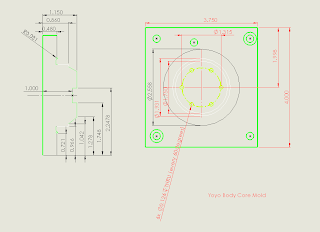See a summary of our cosmic 2.008 journey in our final video HERE!
Cost Analysis
Cost per yoyo (prototyping 100): $28.21
Cost per yoyo (manufacturing 100,000): $1.92
These numbers were calculated according to the Ashby Cost Model, which includes material, equipment, tooling, and overhead costs. However, we overlooked the cost of student labor in our calculations.
Materials:
m = part mass (0.086 kg)
Cm = material cost ($3.9/kg)
f = waste fraction (0.2)
Tooling:
Ct = tool cost [$/tool]
nt = tool lifetime [parts]
nt = tool lifetime [parts]
n = total runs [parts]
Machinery:
n = production rate (0.2 parts/min)
Cc = equipment cost ($500,000)
L = load factor (0.9)
t = lifetime (10 years)
L = load factor (0.9)
t = lifetime (10 years)
Overhead:
Coh = overhead costs, energy, labor, etc ($50/hr)
n = production rate (60 parts/hr)
In the cost analysis, we accounted for mold manufacturing, cost of resin pellets for injection molding, polystyrene thermoform material, axle sleeves and hex nuts, design labor, staff labor, and machine production run time. As the number of parts manufactured increases, the cost per yoyo decays, as seen below:
Cost per Yoyo [$] vs Number of Yoyos Manufactured
# Yoyos Produced
Mass Production
In adapting our design for mass production, we might make fewer sacrifices in terms of color. We would have liked more time to experiment with colors for our yoyo parts, especially the ring and body. For example, when producing the body, we experimented with marbling but eventually stuck with pure black due to time constraints. With more injection molding machines for mass production, however, we would be able to vary colors of our yoyo parts more easily and be able to offer customers more options for space yoyos without worrying about the crunch for time that comes with having to flush out previous colors from the injector.
The molds would have to be made out of a more robust material like steel in order to withstand more production runs. Additionally, we would redesign our molds to produce perhaps hundreds of the same part of the time. This might involve redesign of the injection molded parts to adapt for the necessary runners between parts. Our themoforming process would be unsustainable in mass production. We would need a rollfeed system into the thermoform machine and then an automatic punch. To further increase cycle time, we might think of using a thinner polystyrene sheet in the thermoforming process. This would require redesign in the injection molded moon and star disc and the moon and star thermoform part to adjust the affected dimensions.
Course Reflections
Our favorite parts of 2.008 were the interactive components of the lectures and our time working in the lab. Applying knowledge from lecture material to in-class examples with small teams was a great way to quickly grasp the concepts of the material. Additionally, the in-class demonstrations put on by Dave and Dave were really interesting and much appreciated. Having access to and being trained on the neat manufacturing machines in the lab was great. Hands-on experience, making molds, optimizing production runs, and cranking out yoyos was fun and extremely useful for learning about industrial fabrication processes. With the relatively large size of the teams, it could be possible to squeeze another type of manufacturing process into the requirements for the yoyo design in addition to injection molding and thermoforming.
In terms of the class structure, we felt the lectures were often long and over-stuffed. A structure with Monday/Wednesday/Friday lectures one hour long could be nicer. Additionally, we covered so many interesting topics within manufacturing that for some parts it would have been nice to choose fewer so as to delve deeper into the subject material. This could be done more smoothly in accordance with the lab assignments, relating the lectures to the yoyo project more tightly. The reading quizzes were very good (we actually did the readings!) but not very fun to have every lecture. And the readings were usually great preparation for the lectures, especially the textbook readings. The research articles towards the end of the semester seemed too complex and unnecessarily stressful for the scope of the lectures and reading quizzes that followed them.
Turning in blog assignments was a fun addition to the course structure, as was the poster session - a nice wrap-up and celebration. This has been a great class. Thank you to Professors Hart and Culpepper and Sanha Kim for the semester. We are so proud of what we were able to accomplish! We felt very well-prepared for the yoyo project and appreciate the great lab instruction - thank you Dave and Dave!
Turning in blog assignments was a fun addition to the course structure, as was the poster session - a nice wrap-up and celebration. This has been a great class. Thank you to Professors Hart and Culpepper and Sanha Kim for the semester. We are so proud of what we were able to accomplish! We felt very well-prepared for the yoyo project and appreciate the great lab instruction - thank you Dave and Dave!





























